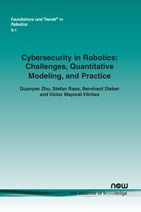Cybersecurity in Robotics: Challenges, Quantitative Modeling, and Practice
By Quanyan Zhu, New York University, USA, qz494@nyu.edu | Stefan Rass, Universität Klagenfurt, Austria, stefan.rass@aau.at | Bernhard Dieber, Joanneum Research, Austria, bernhard.dieber@joanneum.at | Víctor Mayoral Vilches, Alias Robotics and Universität Klagenfurt, Austria, victor@aliasrobotics.com
Abstract
Robotics is becoming more and more ubiquitous, but the pressure to bring systems to market occasionally goes at the cost of neglecting security mechanisms during the development, deployment or while in production. As a result, contemporary robotic systems are vulnerable to diverse attack patterns, and an a posteriori hardening is at least challenging, if not impossible at all. This book aims to stipulate the inclusion of security in robotics from the earliest design phases onward and with a special focus on the costbenefit tradeoff that can otherwise be an inhibitor for the fast development of affordable systems. We advocate quantitative methods of security management and design, covering vulnerability scoring systems tailored to robotic systems, and accounting for the highly distributed nature of robots as an interplay of potentially very many components. A powerful quantitative approach to model-based security is offered by game theory, providing a rich spectrum of techniques to optimize security against various kinds of attacks. Such a multi-perspective view on security is necessary to address the heterogeneity and complexity of robotic systems. This book is intended as an accessible starter for the theoretician and practitioner working in the field.
Cybersecurity in Robotics: Challenges, Quantitative Modeling, and Practice
Robotics is becoming more and more ubiquitous, but the pressure to bring systems to market occasionally goes at the cost of neglecting security mechanisms during the development, deployment or while in production. As a result, contemporary robotic systems are vulnerable to diverse attack patterns, and a posteriori hardening is at least challenging, if not impossible at all. This book aims to stipulate the inclusion of security in robotics from the earliest design phases onward and with a special focus on the cost-benefit tradeoff that can otherwise be an inhibitor for the fast development of affordable systems. Quantitative methods of security management and design are advocated, covering vulnerability scoring systems tailored to robotic systems, and accounting for the highly distributed nature of robots as an interplay of potentially very many components. A powerful quantitative approach to model-based security is offered by game theory, providing a rich spectrum of techniques to optimize security against various kinds of attacks. Such a multi-perspective view on security is necessary to address the heterogeneity and complexity of robotic systems. This book is intended as an accessible starter for the theoretician and practitioner working in the field.
